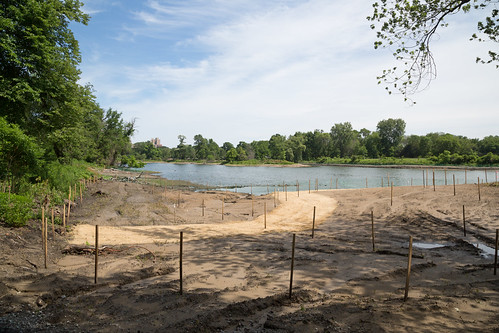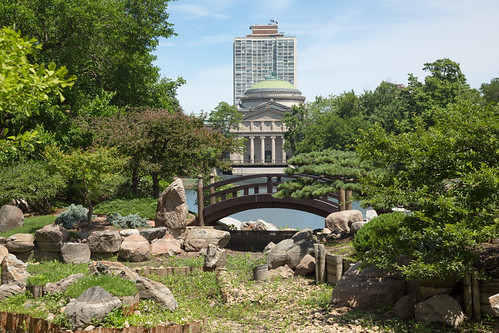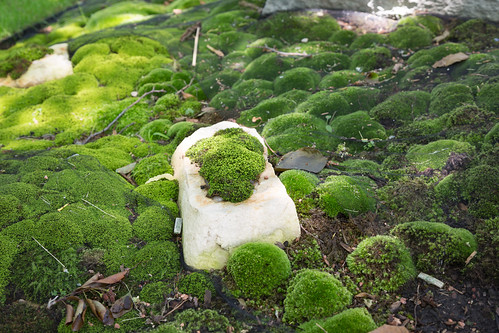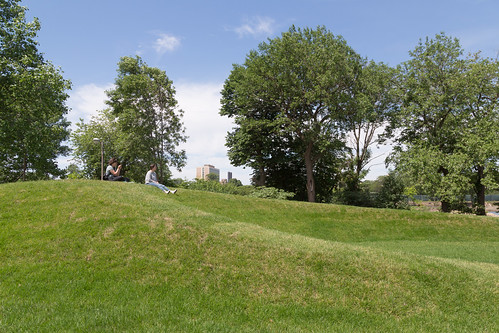| « Chiraq vs. the Good in Englewood? | What to Do With All Those Leftover Fireworks » |
Environment/Sustainability Fri Jul 03 2015
Rehabilitating Wooded Island and Installing Yoko Ono's "Sky Landing"
Jackson Park's Wooded Island is currently closed to the public while it is being reworked by a consortium of groups led by the Army Corps of Engineers, but last Saturday the Chicago Park District offered a special tour of the island's rehabilitation and Yoko Ono's in-process sculpture,"Sky Landing."
The multi-year restoration of the park is designed to accomplish several objectives, including removing "low quality species," (re-)introducing native species, replacing park infrastructure, and introducing new landscape elements. Because the park is on the National Register of Historic Places, all of these objectives must be balanced against the historic character of the park, which was designed and redesigned by such titans as Frederick Law Olmsted, Calvert Vaux, and Daniel H. Burnham.
The interface of the historical and environmental sensitivities can be seen in how the park's hardscape has been adjusted to protect existing natural elements. In some cases the path has been rerouted to protect mature trees, leaving benches several feet from the path they once flanked. In other places, younger trees were cleared to make way for the introduction of landscape overview points that were generally envisioned by Olmsted but never constructed.
At present, these overlooks provide new views of the park and offer glimpses of a landscape in transition. Among the most visible changes is that the lagoons that surround the island have been partially drained to allow crews to rework the lagoon banks and to plant new species in and around the water.
The northern edge of the island is experiencing a different kind of change. Project 120, the private group remaking portions of Jackson Park, is in the process of rebranding and rebuilding the areas around Osaka Garden. The garden, which was built on the island in 1935 on the site of the former Japanese Ho-o-Den during the 1893 World's Columbian Exposition, will now be joined by Yoko Ono's new installation, "Sky Landing," and other structures off the island. Few changes are occurring inside Osaka Garden, itself, but the Chicago Park District has installed new mosses, among other small changes.
Because Project 120 is not doing any significant public engagement work about its vision for the park or for its portion of the construction effort, the tour offered one of the first public views of Yoko Ono's installation. At this present, the first phase of the project is complete, with two mounds installed in front of the Osaka Garden. The project is to be completed by June 2016, at which point the new sculpture will be unveiled to the public.
If you are interested seeing in the landscape's transition in person, you may have two opportunities to visit the island this summer. The first opportunity is through the stewardship program, through which volunteers help the district with "tree mulching, invasive plant species removal, seeding, or planting" on the island. The next such event is on July 25. The second opportunity may be through additional tours. Impressed by the number of participants in last weekend's tour, the Chicago Park District may be offering more tours this summer, likely in conjunction with the stewardship days. Check the district's events website for updates.






















Patricia O'Donnell, FASLA, AICP / July 13, 2015 2:06 PM
Thanks David Schalliol for this useful overview and details of the Jackson Park work underway. The project is also sponsored by Project 120 Chicago,http://www.project120chicago.org/ A non-profit that aided in funding the work and in bringing Heritage Landscapes, Olmsted experts, into the team.
An important point is that the Olmsted firm drawings 1895 to 1897 that directed the reconstruction of the park after the exposition were used constantly as a guide for project drawings. The overlooks did exist historically and have been sited in this project in original and modified locations based on changes to the park over the past 120 years.